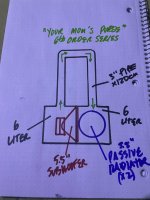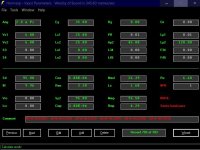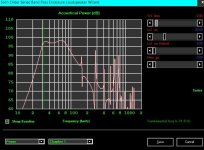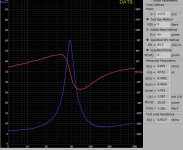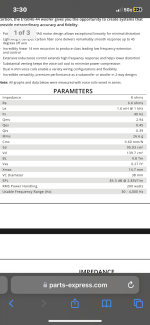Recovery bed ponderings
With folks making efforts with bracing and damping, I got thinking about the other extreme. I imagine a sub driver fitted into the entry of a balloon and inflated to atmospheric pressure or so
How would that go? Thoughts?
With folks making efforts with bracing and damping, I got thinking about the other extreme. I imagine a sub driver fitted into the entry of a balloon and inflated to atmospheric pressure or so
How would that go? Thoughts?
For every action, there is an equal and opposite reaction. Front pressure = back pressure. Assuming the driver had an appropriate suspension for proper cone behavior, (Probably a free air driver here since the balloon provides no, or little suspension) I think that the balloon would expand/contract so easily it would sound like there were no balloon there at all- The back pressure would be generated in equal quantity to the front pressure, and you would get all of the position specific bass cancellation you would get it the driver were just hanging in free air. Now if you can just delay the back pressure so it matches the phase of the front pressure, and direct it in a better direction you would have something, which is what labyrinth/maze speaker enclosures do.
All the best to you!Recovery bed ponderings
The tuning would probably be rather uncontrollable and very high.How would that go? Thoughts?
Similar to ports the system tuning raises with higher radiator surface.
Practically speaking the balloon surface adds very low weigth compared to a simple open vent, so the "diaphragm" would need added weigth for lower tuning, introducing suspension difficulties.
You also want the balloon to have linear excusion behaviour. But the big surface may help here.
High radiator surface will also potentially transmit more unwanted higher frequencies (including enclosure resonances).
But the main reason for limiting radiator surface is probably the PR cost and tecnical difficulties with high added weigths necessary for big PR surfaces (again adding to cost).
Last edited:
Yeah, IIRC someone advertised a water filled balloon subwoofer in the '80s, but powerful subwoofers driving multiple PRs won out even for modern 16 Hz organ pipe apps in some cases.
Did cerwin Vega have a bladder/balloon you could inflate/deflate as a damper?
You can change the speed of sound and air dencity in hornresponse recently ?
You can change the speed of sound and air dencity in hornresponse recently ?
Trying to save space here. I'm deciding what kind of enclosure to use for some Sony 1-859-076-21 magnetic fluid speakers. I cannot find any specs for this driver, so I used specs from a similar sized one to calculate a sealed enclosure volume and resonant frequency. Vas = 0.02 ft^3, Fs = 113 Hz, Qts = 0.44
Qtc Vb (L) F3 Fb
0.707 0.36 182 182
0.6 0.66 186 154
0.5 1.94 200 128
Those sizes are a little big for my taste. I was thinking what if you use a plastic bag or balloon instead. They would only be 1/2 filled, and ideally, the...
Qtc Vb (L) F3 Fb
0.707 0.36 182 182
0.6 0.66 186 154
0.5 1.94 200 128
Those sizes are a little big for my taste. I was thinking what if you use a plastic bag or balloon instead. They would only be 1/2 filled, and ideally, the...
- UncleJoe
- Replies: 16
- Forum: Full Range
Thank youAll the best to you!
Guys, recognising the impracticality of a spherical bladder for a cab, let's instead change the cab to a tetrahedron. Base face as the floor, forward face as baffle and the two rearward as rubber membranes. Enough stuffing to damp the membranes from flapperating and creating unwanted buzz
Pic swiped from online to illustrate the shape
And to add to that, a quarter wave length/depth tetrahedron taper with open back end and membrane walls. @Booger weldz, what will this do to your pet resonances :/
Adding too much PR surface will reduce efficiency but improve linearity. The trick is to be in the PRs linear compliance range, avoiding compression from operating at its suspension limits. The onset of this makes odd order harmonics rise suddenly and sharply, just like running the active driver beyond xmax.
Comparing PRs to ports, a decent quality, correctly sized PR will always sound cleaner than an average sized port. The audible onset of port compression is more subtle and gradual compared to a PR run into its compliance limits. However, a correctly sized port can reveal more subtle macro dynamics in the bass than any PR. This is due to the way the air accelerates in the port, responding much faster than the added mass of a PR, including its suspension resistance and losses. I apply this reasoning to the port itself, always aiming to achieve the shortest possible port length. You avoid port resonances doing this and reduce parasitic losses, but the airflow in and out of the port can't always transition as smoothly, increasing losses and non-linearity. Using the largest possible port surface area reduces this, usually to the point of insignificance, but it requires a relatively large enclosure to reduce port length requirements for sufficiently low system tunings.
When I worked at ACR back in the late 80s, I had the idea of using a smoke machine to study port airflow and to optimize port geometry for various designs I developed. This revealed critical limitations in traditional port designs used by many other manufacturers, specifically so in at the time less researched 4th order bandpass enclosures.
From a simple physics standpoint, any preloading force pushing back on the active driver is undesirable. This is in response to the balloon analogy applied to PR systems. As with any LF driver, suspension preload and resistance hurts low level detail retrieval and increases HD in the lower mids. The volume of enclosed air space is considerably more linear than the mechanical suspension of any cone driver, as long as the ratio of enclosure air volume to maximum cone displaced air volume is high. Small volume, large cone subs can suffer from IMD issues at higher excursion levels.
The bladders people referred to in Cerwin Wega speakers are there to decrease system resonance Fc. This is done by filling the bladder with sulfur hexaflouride, which is a very dense and heavy gas.
Comparing PRs to ports, a decent quality, correctly sized PR will always sound cleaner than an average sized port. The audible onset of port compression is more subtle and gradual compared to a PR run into its compliance limits. However, a correctly sized port can reveal more subtle macro dynamics in the bass than any PR. This is due to the way the air accelerates in the port, responding much faster than the added mass of a PR, including its suspension resistance and losses. I apply this reasoning to the port itself, always aiming to achieve the shortest possible port length. You avoid port resonances doing this and reduce parasitic losses, but the airflow in and out of the port can't always transition as smoothly, increasing losses and non-linearity. Using the largest possible port surface area reduces this, usually to the point of insignificance, but it requires a relatively large enclosure to reduce port length requirements for sufficiently low system tunings.
When I worked at ACR back in the late 80s, I had the idea of using a smoke machine to study port airflow and to optimize port geometry for various designs I developed. This revealed critical limitations in traditional port designs used by many other manufacturers, specifically so in at the time less researched 4th order bandpass enclosures.
From a simple physics standpoint, any preloading force pushing back on the active driver is undesirable. This is in response to the balloon analogy applied to PR systems. As with any LF driver, suspension preload and resistance hurts low level detail retrieval and increases HD in the lower mids. The volume of enclosed air space is considerably more linear than the mechanical suspension of any cone driver, as long as the ratio of enclosure air volume to maximum cone displaced air volume is high. Small volume, large cone subs can suffer from IMD issues at higher excursion levels.
The bladders people referred to in Cerwin Wega speakers are there to decrease system resonance Fc. This is done by filling the bladder with sulfur hexaflouride, which is a very dense and heavy gas.
Last edited:
@Booger weldz Those Epique carbon fiber cone drivers are nice. They unfortunately suffer from somewhat leaky cone surfaces. This can be audible under certain conditions. They're a pretty good deal aside from this small issue.
Standout reasoning!However, a correctly sized port can reveal more subtle macro dynamics in the bass than any PR. This is due to the way the air accelerates in the port, responding much faster than the added mass of a PR, including its suspension resistance and losses
Distortion, even IMD can be a funny thing. Maybe I just enjoy being involved with the music that I am listening to or enjoy music that has been interfered with. Take the Small Axe dub and play it back through a two-way 15 ported lowish. It's super trippy and much more enjoyable than through monitors. The sealed system sound is too dry to draw me in. With the resonant systems, I sort of hear a spill to the bass. Don't know how to describe it better than that. And that lil shiver added to the small axe dub might be IMD, not sure on this. Driver in use is a 12w7 ported 35hz and 1kwrms
This effect is absent when with the same track played back on my home system
Going back to max radiating area, but first something I need to get my head around! Just how much xmax is run just to even produce 30hz? Is there a minimum distance a diaphragm has to travel to create a 30hz sound wave?
This effect is absent when with the same track played back on my home system
Going back to max radiating area, but first something I need to get my head around! Just how much xmax is run just to even produce 30hz? Is there a minimum distance a diaphragm has to travel to create a 30hz sound wave?
Very interesting ... so you were some 35 years ahead of me!When I worked at ACR back in the late 80s, I had the idea of using a smoke machine to study port airflow and to optimize port geometry for various designs I developed.
What geometry did you conclude is ideal?
Going back to max radiating area, but first something I need to get my head around! Just how much xmax is run just to even produce 30hz? Is there a minimum distance a diaphragm has to travel to create a 30hz sound wave?
Piston Excursion calculator
@stv The most efficient port design at that time was a rectangular shelf at the end or middle of the box. There was a length reduction factor between 15 - 20 % if the port shared an outer enclosure boundary. A baffle centered port required two drivers, one on each side, to prevent cone rocking modes at higher output levels above the tuning frequency. The centered shelf port also wasn't very good for midbass frequencies as it accentuated the second harmonic standing wave of the enclosure. Two shelf ports on opposite ends of the driver(s) was the cleanest low end along with decent midbass.
I modeled some of my designs after the Procus Fidibus speaker, which uses a 4th order bandpass enclosure scheme. The BP4 enclosure design gets a bad rap due boxes being pushed past the upper cutoff. The LP point has to be within actual useful bandwidth. Port resonances aren't an issue with a BP4 box as long as the crossover keeps most of the outside bandwidth from being fed to the woofers. These enclosures are capable of very clean and accurate bass if the bandwidth factor (S) is kept below 7.
I modeled some of my designs after the Procus Fidibus speaker, which uses a 4th order bandpass enclosure scheme. The BP4 enclosure design gets a bad rap due boxes being pushed past the upper cutoff. The LP point has to be within actual useful bandwidth. Port resonances aren't an issue with a BP4 box as long as the crossover keeps most of the outside bandwidth from being fed to the woofers. These enclosures are capable of very clean and accurate bass if the bandwidth factor (S) is kept below 7.
Attachments
Xmax is linear excursion.Just how much xmax is run just to even produce 30hz?
Any moving cone can produce 30Hz, the SPL is determined by the displacement, Sd X excursion.
The diaphragm has to move more than zero mm to produce sound.Is there a minimum distance a diaphragm has to travel to create a 30hz sound wave?
The Baudline Piston Excursion Calculator GM linked in post 15 makes it easy to determine the excursion required for a given SPL:
Around 69dB SPL is near the minimum level most people are able to hear at 30Hz, a 6" cone can do that with less than 1mm excursion.
Regarding the thread starter question "Can there be too much passive radiator surface?", the answer is yes.
Too much Sd requires too much PR weight to tune low enough to be useful.
@Randy Bassinga ive been messing around with this(number of passive radiators) and the mmp(mass added) to observe what these guys are describing to us.its quite interesting
I recall an article in the long defunct ‘Speaker Builder’ magazine, where the walls of DIY speaker cabinet were mounted to a space frame via highly elastic supports, enabling them to resonate as panels, and move a significant volume of air. Rendering all the wall panels to function as passive radiators. No doubt, tuning all of the walls to the same, and proper frequency would not have been easy, along with other practical flaws. However, it was an interesting concept.
If you accept non-equal sharing of resonator excursion a non-equal free air resonance frequency of several PRs is no problem. The complete system will still have one tuning frequency.No doubt, tuning all of the walls to the same, and proper frequency would not have been easy
- Home
- Loudspeakers
- Subwoofers
- Can there be too much passive radiator surface?
